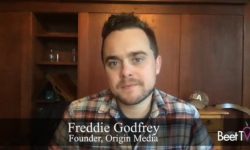More advertisers are relying on a broader set of measurement tools to evaluate the effectiveness of their campaigns. These outcome-based metrics seek to provide more insights into how advertising affects consumer behavior.
“Clients are getting a lot savvier in terms of being able to ask the right questions, to be able to measurable business results to some of the programs that we run,” Michelle Capasso, director of media services at ad agency Connelly Partners, said in this interview with Beet.TV. “If you think back, we did a lot of reporting on digital statistics and impressions and clicks and things that really didn’t have an impact on a client’s business.”
She said her company works with a variety of partners to help clients measure the return on investment (ROI), including outcomes-based ad platform LoopMe.
“More often than not, we are working with our partner companies [and] media vendors to be able to quantify what we’re getting from a return,” Capasso said. “LoopMe has a purchase loop attribution model we can use as well, or anything that ties to foot traffic.”
One of the biggest challenges for marketers is determining which measurements of foot traffic are most meaningful.
“There are a lot of foot traffic attribution vendors in the space, but more often than not, we use a lot of different vendors as part of a buy, and ultimately, they all have their own methodology and model,” Capasso said. “We end up in a situation where we don’t have a really core, solid source of truth.”
Measuring Incremental Reach
Her agency also performed other kinds of incrementality studies to determine when clients are reaching and converting new customers, though these measurements also present challenges for marketers.
“We’ve worked with some vendors on some match-back studies when we’ve had clients that have a core database of consumers that they know, and then they’re looking to see what that incrementality is,” Capasso said. “I don’t think we’ve totally cracked the nut on incrementality, but it comes up more and more often with clients. The pressure on business outcomes is rapidly evolving.”
The pandemic led to a dramatic shift in people’s viewing habits when they were stuck at home during lockdowns. In many cases, marketers had more ways to reach consumers through digital platforms including social media.
“We’re excited about the shift in habits. There are more ways to get to somebody,” Capasso said. “There are more opportunities for cross-channel engagement. The social space for us is hugely exciting.”
Advertisers also are evaluating their media investments in the context of protecting people’s privacy and promoting diversity and inclusion.
“These are things that media buyers have never had to think about,” Capasso said. “We now need to think about all of these things, and I don’t think that’s a bad thing. It’s a great place for a media buyer to be, and it’s a pretty exciting time.”
You are watching “Outcomes-Based Advertising: Connecting Ad Exposure to Business Results,” a Beet.TV Leadership Series presented by LoopMe. For more videos, please visit this page.











































